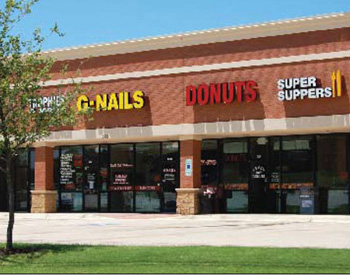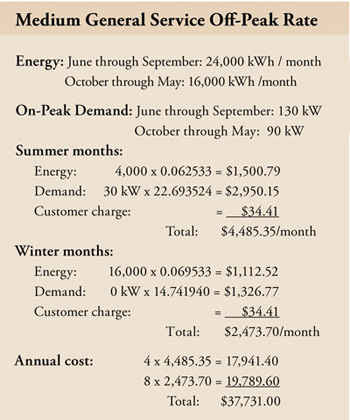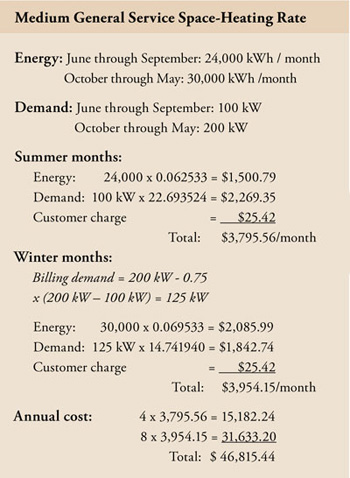To protect your and your company’s wallets, it is very important to understand the rates for which you are being charged for electricity. In this segment, I am going to share with you and discuss in detail the small commercial electric rates of a typical utility. The example I am using is a utility that publishes their rates on the Internet. The electric rates for which you are being billed may vary greatly from my example. I recommend that you contact your utility to get a copy of your rate and find out what other rates are available to you. Some of the terms I am using in this article have been previously defined and discussed in parts 1 and 2 of this series.

Photo 1. Typical small commercial businesses.
Medium General Service Rate
For our example utility, their medium general service rate is available to any customer having a monthly energy use exceeding 3,500 kWh and a summer maximum measured fifteen-minute demand of less than 300 kW. This is the basic rate for most small commercial customers. For our example utility, this rate has a customer charge of $25.42 per month. The energy charge is 6.2533 cents per kWh in the summer months and 6.9533 cents per kWh in the winter months. The demand charge is $22.6935 per kW in the summer months and $14.7419 per kW in the winter months. The measured demand is the greatest demand established by the customer during any fifteen-minute period of the month taken to the nearest whole kilowatt, but not less than 1 kW. Note that the demand is not time dependent. On this rate, hitting a peak fifteen-minute demand at 2 a.m. is just as expensive as one at 2 p.m.

Table 1. Medium General Service Rate
For a restaurant that uses 24,000 kWh of energy with a 150 kW demand in a summer month, the bill will be $1,500.79 for energy, $3,404.02 for demand, and $25.42 for customer charge. The demand charge is over two times the energy charge. If load management can be done to reduce the demand, a significant savings can be achieved. In one such case with which I was involved, a few hundred dollars of electrical work saved a restaurant thousands of dollars in their electric bills each month. The dining area of the restaurant was air-conditioned with two units. Under the worst case outside temperature conditions, the two units were each on less than half the time. This meant the units could be operated one at a time, and they would still maintain the desired temperature. The owner had an electrician wire the controls so that only one unit could be on at a time. The unit that operated more frequently (the one that cooled the area closest to the kitchen) was designated the primary unit. If the primary unit was on, the other unit could not turn on until the primary unit’s thermostat was satisfied. The result was a fifty percent reduction in the air conditioning demand. The air conditioning demand was a large piece of the restaurant’s total demand. For a restaurant that uses 24,000 kWh of energy with a 150 kW demand each month in the summer months and 16,000 kWh of energy with a 100 kW demand each month in the winter months, the annual bill would be $40,617.96 on this rate.
Medium General Service Off-Peak Rate

Table 2. Medium General Service Off-Peak Rate
Our example utility has an optional service very similar to the above rate except that the demand is only measured during on-peak hours. For this rate, on-peak hours are 6:00 a.m. to 10:00 p.m. Monday through Friday. During Daylight Savings Time, on-peak hours are 9:00 a.m. to 10:00 p.m. Monday through Friday. Note that the on-peak hours during Daylight Savings Time (summer) are very different from the normal on-peak hours. Since the on-peak time starts at 9 a.m. in the summer, turning on the air-conditioning system well before 9 a.m. to cool the building down is usually a good cost saving move. All the charges are the same as the medium general service rate except there is an additional service charge of $8.99 per month. Because the customer pays the additional service charge, the utility ignores off-peak demand. Under this rate, if you use equipment like elevators that use a lot of power for short periods of time during off-peak hours, you pay for only the energy associated with the use of the equipment. Under this rate, a small commercial establishment that uses 24,000 kWh of energy with a 130 kW on-peak demand each month in the summer months and 16,000 kWh of energy with a 90 kW on-peak demand each month in the winter months, would have an annual bill of $37,731.00.
Medium General Service Space-Heating Rate

Table 3. Medium General Service Space-Heating Rate
Our example utility also has an optional service for customers where at least one third of the demand during the heating season is from electric resistance heat or electric heat pump. For this rate, during the months October through May, the billing demand will be reduced by 75% of its excess, if any, over the greatest billing demand of the previous billing months of June through September. For example, if the measured demand for the month of December was 200 kW and the previous summer maximum demand was 100 kW, the customer’s billing demand for December would be 125 kW.
Billing demand = 200 kW – 0.75
x (200 kW – 100 kW) = 125 kW
The charges for this rate are the same as for the medium general service rate. Under this rate, a small commercial establishment with electric heat that uses 24,000 kWh of energy with a 100 kW demand each month in the summer months and 30,000 kWh of energy with a 200 kW demand each month in the winter months, would have an annual bill of $46,815.44. If the same customer were on the Medium General Service Rate, they would pay $8,845.16 more each year.
Next time, in Part 4, I will get into the details of the rates that apply to large commercial and industrial facilities.














Find Us on Socials